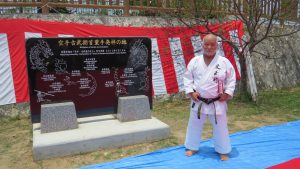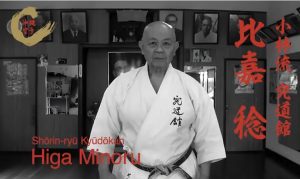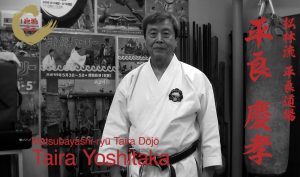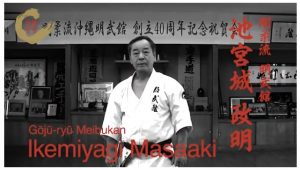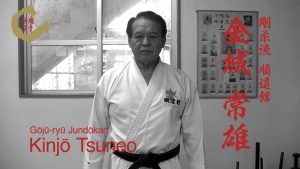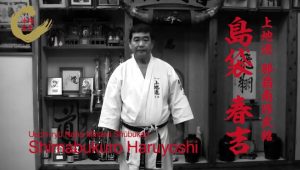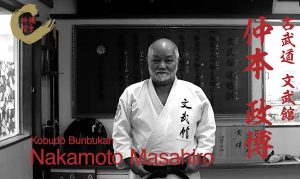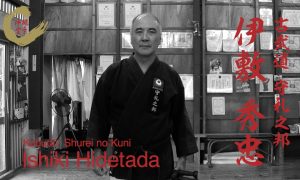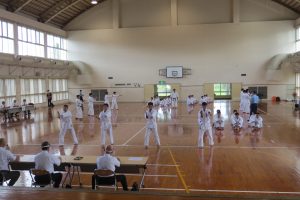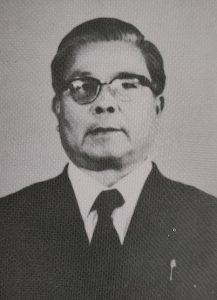Special feature articles
-
2023.09.19
Karate Today - Yoshizato Hiroshi's Birth!
-
2023.08.29
Karate Today - Honolulu Karate Youth Club Found...
-
2023.08.15
Karate Today - Nakandakari’s Birth!
-
2023.08.03
Karate Today - Noma Seiji made his wedding in O...
-
2023.07.18
Karate Today - Yabu Kentsu conducts Karate prom...
-
2023.07.04
Karate Today - First "Karate Club" created for ...
-
2023.06.20
Karate Today - Yoshimura Chogi visited the form...
-
2023.06.06
Karate Today - Karate club at Prefectural First...
-
2023.05.26
Karate Today series will begin
-
2021.12.20
Martial arts demonstration in front of the king...
-
2021.03.08
Folktale: Why tigers can't climb trees
-
2020.12.22
About Rei – Part 2 by Nakamoto Masahiro
-
2020.11.17
Okinawa Karate "WA" Series
-
2020.10.05
About Rei – Part 1: Mabuni Kenei
-
2020.06.19
1969 article on master Yagi and Sūpārinpe
-
2020.05.22
1969 article on master Higa and Passai Dai
-
2020.05.08
1969 article on master Shimabukuro and Ānankū
-
2020.04.20
1969 article on master Kushi and Wankan
-
2020.04.14
1969 article on masters Kaneshima and Nagamine
-
2020.04.09
Article ”Even at 80 years old “Eyaa!” ” (Okinaw...
-
2020.04.09
Article ”Impressed with every move” (Ryūkyū Shi...
-
2019.12.03
Kobudō 9: Nakaima Kenkō and Uchima Anyū
-
2019.11.07
Kobudō 8: Kyan Shinei and Kaneshima Shinei
-
2019.10.29
Kobudō 7: Ishikawa Hōei and Higa Seitoku
-
2019.10.08
Kobudō 6: Nohara Kamaichi and Takara Shigeru
-
2019.09.13
About the estimated new photo of Itosu Ankō
-
2019.09.02
Karate policemen protecting the safety and secu...
-
2019.07.02
Kobudō 5: Soken Hōhan and Shiroma Taisei
-
2019.06.08
Kobudō 4: Kameshima Shinsuke and Chinen Masami
-
2019.06.01
Kobudō 3: Nakamura Shigeru and Higa Yūsuke
-
2019.05.24
Kobudō 2: Irei Matsutarō and Nakamura Heisaburō
-
2019.05.14
Kobudō 1: Kina Shōsei and Shinjō Heisaburō
-
2019.04.08
Questioning the weapons’ hunt
-
2019.01.21
Kyō Ahagon Jikki, the sword and karate
-
2018.05.04
The unveiling of the statue of Uechi Kanbun
-
2017.12.26
Following the steps of Matsumora Kōsaku
-
2017.10.20
Brushwork of late Matsumura Sōkon
-
2017.10.14
Maekawa bō performed at the Shihan Gakkō
-
2017.09.08
The declaration of the "Karate Day"
-
2017.08.15
A district connected to karate, Uebaru
-
2017.07.14
The beauty of Okinawa karate
Bu “starts with Rei and ends with Rei”
If you put this in practice in your daily life, it will lead to the best of life. It is important to respect and esteem others. Regarding etiquette, “Rei” is not just about bowing. It is a form of prayer for the success and safety of a demonstration, a way of expressing gratitude to the past masters who devised the kata of martial arts, to the audience, to the performance venue (living thing that is the wood that forms the walls and atmosphere), to the weapons we use and to the people who are performing with us.
When you wake up every morning and say hello to your family, students, fellow students or teachers on their way to school, friends and acquaintances that you meet along the way, the other person will also reply. While living a social life, this leads to a smooth, calm and peaceful life.
“Shitsurei" (as in "excuse me” or a lack of gratitude) means to ignore the other party. "Kiri-sute gomen" - In the Edo period, there was a time when cutting down general commoners, tradesmen, and peasants who behaved rudely towards the samurai class would not be blamed. In all human relationships, the role of "respectful morale" is huge. Originally, the ultimate goal of Japanese martial arts resided in one point: "Uyamau (Kei)" meaning “respect”.
The old form for the character “Rei” has the meaning of offering sake to the gods. According to the Kadokawa dictionary on the origins of characters, there are: 1) Courtesy (Etiquette / Festival), 2) Ceremony (Dress code / Ceremony of proclamation of a Crown Prince), 3) How to show respect toward others (Rudeness / Impoliteness), 4) Gratitude; Expressing gratitude (Thank-you note / Remuneration) 5) Bow. Greetings (Worship / Eyes greetings) are mentioned among others.
When performing karate and kobudō, make sure to bow at the beginning and end of the performance. Bu or martial arts begins and ends with a bow, as a sign of courtesy and gratitude. We all have been strictly taught in this way. Rei is also a form of prayer that calms the heart, nurture a strong force and leads to realization. If you forget Rei, you will soon feel powerless. It is said that “A warrior dies for someone who knows him” (‘Historical records’). To know is to believe, and to always show gratitude should become a daily custom.
Okinawa Prefecture designated intangible cultural asset holder for “Okinawa Karate and Kobujutsu”
Chairman of the Okinawa Traditional Kobudō Preservation Society Bunbukan HDQRS.
Nakamoto Masahiro
82 years old
Many dōjō within the Okinawa prefecture have resumed their training. But in the midst of the Covid-19 pandemic, international karate enthusiasts still cannot visit Okinawa. In order to meet their demands, our information center has launched a new project titled “Okinawa Karate ‘WA’ Series”.
With the cooperation of instructors who have welcome and taught visiting karateka introduced by our center since its opening in 2017, we present you some videos showcasing the essence of Okinawa karate.
The title of the series, "WA" is usually understood as harmony. However, we chose a Japanese character meaning “to circulate, to surround, to go around,” with the hope that the martial art of Peace that is Okinawa karate will bring peace worldwide. "WA" is also an acronym for the words “Word” and “Action”, the concept on which this series is based.
Through this project, we hope to bring some encouragement to karate enthusiasts all over the world to keep training until they can come to Okinawa. We will update this page regularly, so please visit us frequently!
Shuri Tomari Te systems (Shōrin-ryū)
1. Kakie, Shōrin-ryū - Higa Minoru sensei
2. Gedan-barai, Matsubayashi-ryū - Taira Yoshitaka sensei
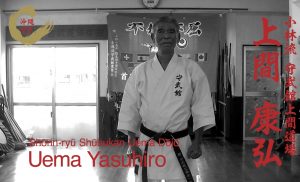
3. Itosu no Passai, Shōrin-ryū - Uema Yasuhiro sensei
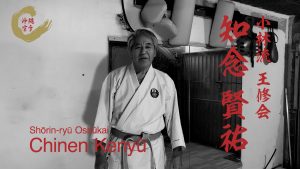
4. Pin-an Sandan, Shōrin-ryū - Chinen Kenyū
Naha Te (Gōjū-ryū)
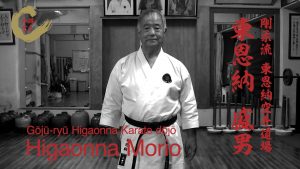
1. Kakie, Gōjū-ryū - Higaonna Morio sensei
2. Sanchin, Gōjū-ryū - Ikemiyagi Masaaki sensei
3. Sandan uke, Gōjū-ryū - Kinjō Tsuneo sensei
Uechi-ryū
1. Hojo undo (auxiliary exercise), Uechi-ryū - Shimabukuro Haruyoshi sensei
Kobudō
1. Nunchaku, Kobudō - Nakamoto Nasahiro sensei
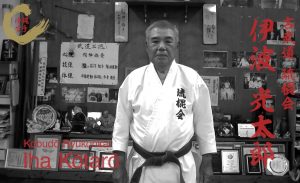
2. Bō-jutsu, Kobudō - Iha Kōtarō sensei
The article below written by Mabuni Kenei sensei, son of the founder of Shitō-ryū Mabuni Kenwa sensei, is part one of a series of two articles relating to Rei.
Rei can mean “to bow” as in “Shomen ni rei – Bow to the front”, but also translate as gratitude, etiquette and proprieties as in “Shurei mon”, the Gate of proprieties at the entrance of Shuri Castle.
Part two is an article written by Nakamoto Masahiro sensei, intangible cultural asset holder for Okinawa karate and kobudō as designated by the Okinawa Prefecture. (Coming soon)
(Photo courtesy from Mr. Sam Moledzki, President, Karate-do Shito-Kai Canada)
********
Mabuni Kenei
JKF Central Qualification Examiner
In all martial arts, sports, and in daily life, one of the most important things is “Rei.”
It is the same in karatedō. It is the most important matter, the first thing to be learned. Rei is not simply a formal lowering of the head, but a method of first correcting one's heart when facing someone, and then correcting one's posture to give a bow.
As for Rei, there is no problem for us Japanese people, but I was made to think about it by some foreigners.
At a dōjō in Central and South America, all the seniors and students lined up to perform Rei at the beginning of the lesson. As all of them were sitting upright in "Seiza", they prepared to bow on the command “Rei”. So far, it was very good but the essential aspect of "Rei" was wrong. All kept their hands on their knees and just knocked lightly their heads down. As all the students were enthusiastic and praiseworthy, I couldn’t understand what happened so I asked the seniors. I thus found out that the Japanese teacher who had been teaching before was so doing when being bowed to by the students. I think that if both the teacher and the learners had corrected their minds first, they would never have done this kind of bowing. (1)
Another episode that happened in another city. It was decided to hold a karate demonstration with the students of a university in this area. The venue, the gymnasium was soon overcrowded with the crowd that had come early. The space where we would perform was narrow, and the audience was only about two meters away from us. In the front row, women were sitting in chairs. If we sat in Seiza and “bow” toward the front as usual, it would inevitably be a respectful salute to the ladies. Somehow it didn’t seem correct. At that moment, I decided to stand in the front and executed a mutual bow with the students.
In the case of bowing, as a custom, I thought it should not be done as a formality. If needed, the method should be considered depending on the place.
In the demonstration of karatedō kata, there are also some movements that express Rei. These moves are aimed at warning against pride, and when performing in front of a large crowd, as our masters and seniors look upon our performances, we ask for their future guidance. The lessons of karate are "Karate ni sente nashi – There is no first attack in karate" and "Kunshi no ken – A gentleman’s fist”. These saying mean to train the fists and feet silently, to never hurt people and always treat people with a gentleman's attitude. In this way, the true purpose of karate is to cultivate a noble character and attitude by respecting etiquette.
Published in the Karate Shinbun Issue 93
Tenbōsha column
Publisher: Karate Shinbun Corporation
Date: March 20, 1977
Note:
(1) the proper way to execute Rei when kneeling:
From seiza (kneeling) with your hands on your thighs, facing the front of the dōjō, place first your left palm and then the right palm on the floor in front of you and then keeping your neck in alignment with your back bow. After a short pause, and after the instructor has completed his/her bow, raise again to the seiza position, retracting first your right hand and then your left placing them on your thighs.
On September 15th, the Okinawa Prefectural Police Academy in Ishikawa City held the first dan grading test for this year. It was held under the supervision of the Okinawa Prefecture Karate Federation.
Training at the academy is directed by Uechi-ryū Kenyūkai Higa Susumu.
All 34 short-term students (including 10 women) succeed in their test and were awarded the Shodan or 1st degree black belt. The test for long-term students (other than university graduate) is scheduled for November.
More on this matter at this page.
On December 3, 1978, at the Okinawa International University, the 1st All Okinawa Karatedō Championship sponsored by the Uechi-ryū Karatedō Association was held. In the tournament’s program can be found the congratulatory address of Nakaima Kenkō, Chairman of the Ryūei-ryū Karatedō Kobudō Hozonkai (Preservation Society) that we have translated below.
The above photo of Nakaima sensei was used in the program. However, it was originally published in the 1977 book "Okinawa Karatedō - History and Techniques" by Uechi Kan-ei sensei.
********
Congratulating you on this event, I humbly would like to address the following message.
A secret martial art of self-defense for common people known as “Tī”, karatedō in Okinawa was developed, nurtured and inherited in the historical, geographical and social specific environment of Okinawa. In the midst of its development process, we cannot denied the possibility that it was influenced by Chinese kenpō. As an evidence, today still, some systems still inherit Chinese martial arts.
When the Japanese feudal system and the Ryūkyū dynasty system collapsed, martial arts that prospered as the main accomplishments of Bushi also temporarily declined. However their value was once again recognized, and they were introduced in the military, police and school education, so called kendō, judō, etc. They came to the light again as practical methods, a way to improve the quality of the youth, a physical and mental training, and a path to character building.
In the shadow of other martial arts, karate did not easily surface socially. However, after it was registered as a martial art of the Dai Nippon Butokukai at the beginning of the Shōwa era (1), it began to stand side by side with other martial arts as “karatedō”. As the birthplace and origin of karatedō, Okinawa is proud that karate is a part of the Japanese martial arts history.
The Manchurian Incident of 1931 triggered the Chinese Incident (2) and Japan eventually entered WWII. The world became a place of truly turbulent disturbances. “If you don't have the same level of national power or more, you shouldn't go to war.” This is the ABC of the Art of war. However, a reckless war was started and even the traditional expressions “Uchi shite yaman” and “Ichi oku gyokusai” (3) were lost in vain.
Among the many generals, General of the Army MacArthur was a unique figure as he researched the Japanese spirit. He stressed that it was the "Yamato-Damashī" (4) that defined the mental attitude of the Japanese who started a war although Japan’s national power was disproportionate to the one of the United States. As this spirit was rooted in Japanese martial arts, thus he banned martial arts completely. Particularly, kendō and jūkendō (5) were strictly prohibited. However, he didn’t mind about karatedō as he knew the virtue of this martial art seeking peace in which there is no first attack.
After the end of the war, all martial arts achieved a 180 degrees turnaround transformation and re-started a a sport, and became as prosperous as they were before the war. Especially, in the case of karatedō, it seems better to say that its flourishment was amazing. Japanese people have a genius ability to take in, assimilate and master the excellent things of other countries and ethnic groups. On the mainland, "Sun-dome jiyū-kumite” and “Bōgu-tsuke jiyū-kumite” (6) were quickly devised. Although there was some controversy over the pros and cons of jiyū-kumite for a period of time, it became popular without people having the time to discuss metaphysical and physical issues. Promoted as “This is Japanese karatedō”, jiyū-kumite spread not only in Japan but also in Western countries and conquered the world. Four karatedō world championships have already been held since (7).
Up to this day, the karatedō world in Okinawa has never though too much about this issue. However, I have heard that some styles already practice free sparring, and that other schools are doing their own research. The Okinawa Prefectural Senior High School Physical Education Federation has been using "free-kumite wearing an armor" for several years and the All Japan Senior High School Karatedō Federation is using both "armor-wearing" and "armor less" sparring methods. It seems that it is no longer the time of objecting to karatedō becoming one of a sport. While some people may be worried, if we misunderstand its philosophy and method, then I fear that karatedō, which is a world-famous cultural heritage of Okinawa, will be transformed into something different and that is not worth to be named karatedō.
The Christ said, "If salt loses its taste, it loses its purpose”. In addition, Chinese calligraphy grand master JAHANA Unseki (8) who was born in Okinawa said, "No true calligraphy art can be born without going back to the original calligraphy of Wang Xizhi.” I think that these teachings mean that in both religion and arts, the spirit and origin must always be kept in mind. I believe that the original martial art qualities of karatedō can be deepened through the harmony of karatedō’s "traditional" and "modern" aspects. Therefore, I think that "kata" and "jiyū-kumite" should be the two sides of the same coin, and complement each other like the wheels of a car. I think that if there is a tendency toward either one or the other side, it will result in a loss of the original nature of karate.
Now, in view of the international and historical trends in which this jiyū-kumite is generalizing, it is important for the Okinawa karate world to cope with this issue, decide on a direction based on a though principle and develop this free sparring matter. I believe that we are standing at a critical crossroads. Which direction should we pursue?
I think that the 1st All Okinawa Karatedō Championship sponsored by Uechi-ryū held this fall, is a landmark in the history of Okinawa karatedō, a great wake-up call, and a touchstone.
I would like to extend my deepest homage to the hard work and great dedication of all concerned parties, and pray for the success of this tournament and the brave fight of all players.
Ending my message, allow me to congratulate this event once again.
Notes:
(1) Shōwa era: 1926 to 1989, period of the reign of Emperor Shōwa also known as Hirohito.
(2) In Japanese “Shina jihen” or “Chinese incident”, it is one of the Japanese names of the Sino-Japanese War at that time.
(3) Wartime Japanese slogans. The first could be translated as “I will not stop firing” or “Stop the battle after crushing the enemy” while the second could be translated as “100 million crushed jewels”, meaning One hundred million people die for the glory in fighting against enemy forces rather than surrendering.
(4) Japanese spirit or soul. It is written with 大和 for Yamato and 魂 Tamashī and pronounced damashī.
(5) The Japanese art of bayonet fighting.
(6) Respectively “Non-contact free-kumite" and "free-kumite wearing an armor."
(7) 1st time in 1970 in Japan, 2nd time in 1972 in France, 3rd time in 1975 in the USA, 4th time in 1977 in Japan.
(8) Jahana who lived from 1883 to 1975 studied Chinese calligraphy in China and became one of the most famous calligraphers of Okinawa.
